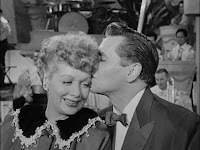An Interview With Author David C. Tucker Pt. 2
This is part two of The Long Live Lucy Forum's original interview with David C. Tucker, author of The Women Who Made Television Funny. View part one.
4. How did television viewers react to seeing Lucille Ball, an older woman, pregnant?
Though nowadays we’re quite accustomed to seeing pregnant actresses continue in their TV roles while they’re expecting, this was quite a novelty in 1952. There was a great deal of resistance on the part of CBS and the sponsor to permitting this storyline. Had I Love Lucy not been the #1 show on television at the time, they probably would have vetoed it altogether.
But viewers were so emotionally involved in the lives of the Ricardos, more so than most sitcom characters, that they responded with great affection and delight to the news. Many of them knew that, in real life, Lucy and Desi had long wanted children, and had suffered through a miscarriage before Lucie was born.
Watch that famous scene in the Tropicana when Lucy breaks the news to Ricky, even today, and see if there’s not a little moisture in your eyes by the time it’s over!

Having A Baby: Lucille Ball and Desi Arnaz
Click photo to enlarge.
5. I've heard about Lucille Ball using a device, recommended to her by Ann Sothern,that lifted her face up. Did Ann Sothern use this device on her series? Were devices like this common among actresses back then?
Yes, both ladies, at one time or another, used such a device, as did stars like Bette Davis. Keep in mind that Hollywood is not necessarily friendly to women over a certain age, and that there is a lot of pressure on actresses, even those in comedy, to remain youthful-looking. The modern-day equivalent, perhaps, aside from plastic surgery, would be something like Botox.
In the 1960s, however, after her second sitcom ended, Ann Sothern grew tired of trying to maintain a glamorous appearance, and began delving into character roles. She allowed herself to gain some of the weight she’d been fighting in the 1950s, and made some interesting films like “Lady in a Cage.” She often said that she found such roles more challenging than leads.




Funny Ladies: Lucille Ball and Ann Sothern
Click photos to enlarge.
6. Recently, there was an essay in Vanity Fair Magazine by Christopher Hitchens titled, "Why Women Aren't Funny."
Why do you think some men still feel this way?
Well, obviously, I don’t agree! :--) I chose to write about the women of 1950s comedy, rather than the men, because I found their work so much more intriguing.
What I gleaned from Mr. Hitchens’ essay was that he believes our society still tends to validate women for being attractive, whereas men are judged from a broader perspective. Whether or not you agree with that, it does seem to be the case that there are relatively few actors who really have a knack for comedy. Joan Davis, who starred in I Married Joan, encouraged her own daughter to pursue comedy, telling her there were already too many aspiring glamourpusses in Hollywood, but not very many good comediennes.
Thanks for the interesting questions!
***
Credits: DizzyArnizzy (Josh) provided the color images of Lucille Ball and Ann Sothern. Book cover art courtesy of McFarland & Company, Inc., Publishers. All other images were provided by GidgetGrape (Sharon). Questions 4 and 5 were written by MoreThanOneSubject (Claude). Questions 1-3 and 6 were written by GidgetGrape (Sharon). Questions answered by David C. Tucker.
The Long Live Lucy Forum wishes to express its thanks and gratitude to David C. Tucker for allowing us to interview him for our blog. The Women Who Made Television Funny is available in bookstores in now. Pick up a copy!



